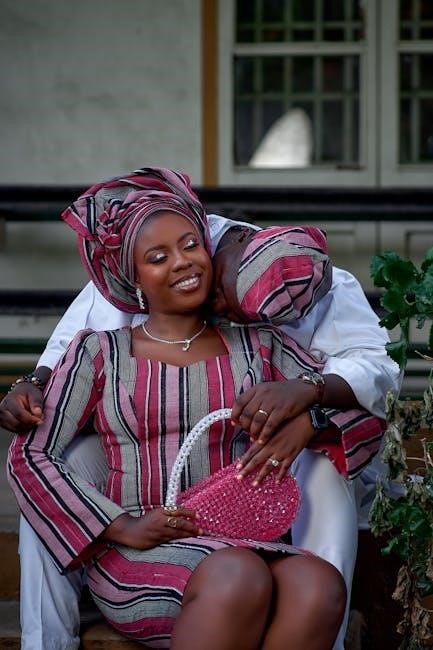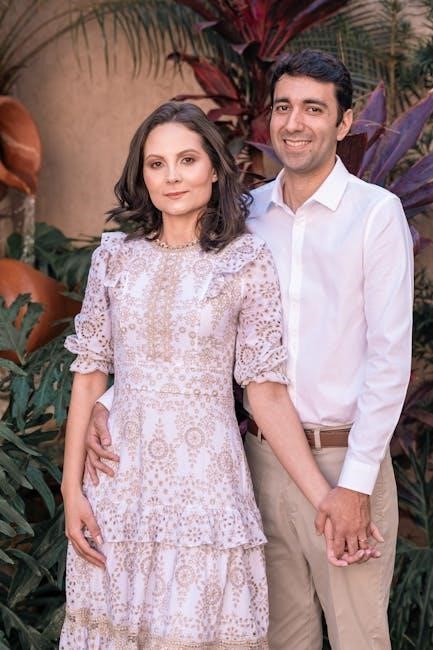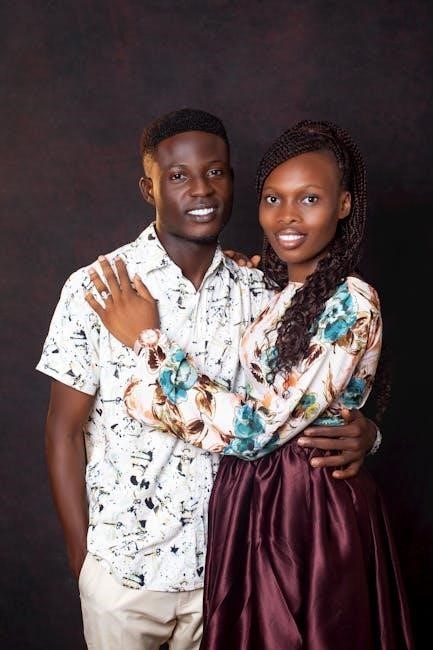
A well-fitting dress shirt is essential for any man’s wardrobe. This guide covers key measurements, styles, and fabrics to help you find the perfect fit, ensuring confidence and comfort.
Understanding the Importance of Proper Fit
A well-fitting dress shirt enhances both style and comfort, ensuring a polished appearance. Proper fit creates a balanced look, avoiding restrictive tightness or unflattering looseness. Ill-fitting shirts can cause discomfort or appear unprofessional, while a tailored fit boosts confidence and complements body proportions. Understanding measurements and styles helps address common issues like shoulder strain or excess fabric. A proper fit is key to making a great first impression, whether for formal events or business casual settings. It’s not just about aesthetics; it’s also about functionality and personal style. Investing in the right fit ensures longevity and satisfaction with your wardrobe choices.
Overview of Key Measurements
Accurate measurements are crucial for a perfect fit. Neck size is measured around the base of the neck, chest size around the fullest part, and sleeve length from the center back to the wrist. These dimensions determine shirt size, ensuring comfort and style. Proper measurements prevent issues like tight collars or excess fabric. Understanding these key points helps in selecting the ideal shirt, ensuring both functionality and a polished look; Take your time to get these right for a flattering and comfortable fit.

How to Measure Your Shirt Size
Use a tape measure to accurately determine your neck, chest, and sleeve measurements. Having someone assist ensures precise results for the best fit and style.
Measuring Your Neck Size
To measure your neck size, wrap a flexible tape measure around the base of your neck, just above your Adam’s apple. Ensure the tape is level and not too tight or loose. The measurement should allow room for one finger to fit comfortably between the tape and your skin. This will give you your neck circumference. If you’re shopping for a dress shirt, this measurement corresponds directly to the collar size. For the most accurate results, have someone assist you with the measurement. Proper neck sizing ensures a comfortable and flattering fit, avoiding a collar that’s either too restrictive or too loose.
Measuring Your Chest Size
To measure your chest size, wrap a flexible tape measure around the widest part of your torso, typically just under your armpits. Ensure the tape is level and not too tight or loose. This measurement will help determine the shirt’s comfort and fit. For dress shirts, the chest size is crucial for ensuring the fabric drapes smoothly across your body. Stand up straight while measuring to get an accurate reading. This measurement is key for selecting the right fit, whether you prefer slim, regular, or classic styles. Proper chest sizing ensures the shirt buttons comfortably and avoids unnecessary tightness or sagging.
Measuring Your Sleeve Length
To measure sleeve length, start by placing the tape measure at the center back of your neck. Extend it down over your shoulder, following the natural curve of your arm, and end at your wrist. Ensure your arm is slightly bent and relaxed for an accurate reading. This measurement ensures the shirt sleeves fit comfortably without being too short or overly long. Proper sleeve length is vital for a polished appearance, as it affects how the shirt sits on your body and aligns with your cuffs. Take note to keep the tape measure level and not too tight, as this can skew the measurement.

Key Considerations for Fit
Key considerations for fit include understanding body type, accurate measurements, and style preferences to ensure comfort and confidence, guiding the perfect shirt selection.
Understanding Slim Fit, Regular Fit, and Classic Fit
Slim Fit shirts are tailored closely to the body, offering a modern, streamlined look. They feature narrower chests and shorter sleeves, ideal for slimmer builds or contemporary styles. Regular Fit shirts provide a balanced cut, not too tight or loose, making them versatile for most body types. Classic Fit shirts are looser, offering maximum comfort and a traditional appearance, often preferred by larger or taller men. Understanding these fits helps in selecting a shirt that complements your body type and personal style, ensuring both comfort and confidence.
How Body Type Affects Shirt Fit
Your body type significantly influences how a dress shirt fits. For muscular builds, ensure the chest and shoulders have enough room without being too loose. Slim men should opt for tailored fits to avoid a boxy appearance. Those with broader shoulders may need a slightly longer sleeve length. Taller men benefit from longer shirts to maintain proportion, while shorter men should avoid overly long sleeves or chests. Understanding your body type helps in selecting a shirt that creates a balanced, polished look, ensuring comfort and confidence in any setting.

Popular Dress Shirt Styles
Dress shirts come in various styles, including Oxford, slim-fit, and classic designs. Each offers unique features like different collars, cuffs, and patterns, catering to diverse tastes and occasions.
Collar Styles: Choosing the Right One for Your Face Shape
Collar styles greatly impact a shirt’s aesthetic and suitability for different face shapes. A point collar complements oval faces, while a spread collar suits round faces. A club collar works well for square faces, softening angles. The wingtip collar is ideal for formal events, pairing best with longer face shapes. Button-down collars add a casual touch, flattering most face types. Consider your face shape and personal style when selecting a collar to ensure a balanced and polished look. Experimenting with different styles can help you find the most flattering fit for your features and wardrobe needs.
Cuff Options: Button, French, andConvertible
Cuff Options: Button, French, and Convertible
Cuff styles play a significant role in the functionality and aesthetics of a dress shirt. Button cuffs are the most common, featuring buttons for a classic and simple look. French cuffs are longer and foldable, requiring cufflinks for a sophisticated, formal appearance. Convertible cuffs offer versatility, designed to work with both buttons and cufflinks. Each style caters to different occasions and personal preferences. Button cuffs are ideal for everyday wear, while French cuffs are reserved for formal events. Convertible cuffs provide flexibility, making them a practical choice for versatile wardrobes. Choosing the right cuff style enhances both comfort and elegance, ensuring a polished finish to your outfit.
Fabric and Material Selection
Fabric and material selection significantly impact comfort and style. Cotton, linen, and synthetic blends offer distinct textures and breathability, catering to various preferences and occasions.
Common Fabrics for Dress Shirts
Common fabrics for dress shirts include cotton, linen, and polyester blends. Cotton is breathable and soft, making it ideal for formal events. Linen is lightweight and perfect for summer, offering a relaxed look. Polyester blends combine durability with ease of care, suitable for everyday wear. Oxford cloth, a popular weave, provides a rugged yet refined texture. Each fabric offers unique benefits, catering to different occasions and preferences. Understanding these materials helps in selecting the right shirt for comfort and style. Choose wisely based on your needs and the event.
How to Choose the Right Fabric for the Occasion
Selecting the right fabric for your dress shirt depends on the occasion and season. For formal events, opt for high-quality cotton or linen, which offer breathability and a polished look. In cooler weather, consider flannel or brushed cotton for warmth. For casual settings, cotton blends or twill are durable and comfortable. Remember, the fabric should match the formality of the event and your personal comfort. Pairing the right fabric with the occasion ensures you look and feel your best. Always consider the dress code and season when making your choice for optimal style and comfort. This balance is key to a perfect outfit.

Common Fit Issues and Solutions
Addressing fit problems like tight collars, baggy chests, or mismatched sleeves requires precise measurements and adjustments. Ensure a tailored look by resolving these issues for optimal comfort and style.
Troubleshooting Shoulder, Chest, and Sleeve Fit
A proper fit across the shoulders, chest, and sleeves is crucial for comfort and aesthetics. If the shoulders feel tight, consider a slightly larger size. For a loose fit, opt for darts or a tailored cut. Ensure the chest lies flat without gaping; if it’s too tight, adjust measurements. Sleeves should reach the wrist bone; if too short, check the fit, and if too long, consider shortening. Addressing these areas ensures a balanced, polished appearance. Proper adjustments can enhance both comfort and style, making the shirt look tailored to your frame. Paying attention to these details guarantees a sharp, professional look.
Addressing Collar and Cuff Fit Problems
A well-fitting collar should sit comfortably around the neck without being too tight or loose. If the collar feels restrictive, consider a larger neck size. Conversely, a collar that gaps may require a smaller size. For cuffs, ensure they fit snugly around the wrist. If cuffs are too loose, they may appear bulky, while tight cuffs can restrict movement. Adjusting the fit or opting for convertible cuffs can resolve these issues. Proper collar and cuff alignment enhances the overall appearance of the shirt, ensuring a polished and professional look. Addressing these details ensures comfort and style, making the shirt a perfect fit for any occasion.
A well-fitted dress shirt enhances confidence and comfort; Consider style, fabric, and measurements to make informed choices, ensuring a perfect fit effortlessly for every occasion.
Final Tips for Finding the Perfect Dress Shirt
When searching for the ideal dress shirt, prioritize proper measurements of your neck, chest, and sleeves. Consider your body type and preferred fit—slim, regular, or classic. Think about the occasion and choose fabrics like cotton for breathability or linen for a casual look. Pay attention to collar styles that complement your face shape and cuff options that suit your lifestyle. Don’t hesitate to try shirts on or consult a tailor for adjustments. Quality and comfort are key, so invest in well-made shirts that reflect your personal style. Remember, a perfect fit boosts confidence and ensures a polished appearance for any event.
Importance of Quality and Comfort
Quality and comfort are paramount when selecting a dress shirt. High-quality fabrics, such as cotton or linen, ensure durability and breathability, while proper fit enhances ease of movement. A comfortable shirt boosts confidence and reduces distraction during the day. Invest in well-crafted shirts with attention to stitching and detail, as they last longer and maintain their shape. Prioritize soft, natural fabrics that feel good against the skin. Remember, a shirt that combines quality and comfort is not just an investment in your wardrobe but also in your daily well-being and professional appearance. Always choose materials and fits that align with your lifestyle and needs.
 bottom guide for sliding shower doors
bottom guide for sliding shower doors  harvest right troubleshooting guide
harvest right troubleshooting guide  tails noir trophy guide
tails noir trophy guide  san francisco travel guide map
san francisco travel guide map  antenna tv guide austin tx
antenna tv guide austin tx  act math study guide pdf
act math study guide pdf  king of the underworld rj kane pdf
king of the underworld rj kane pdf  merlin home transmitter manual
merlin home transmitter manual  contrat de sous-location québec pdf
contrat de sous-location québec pdf  mark cousins the story of film pdf
mark cousins the story of film pdf